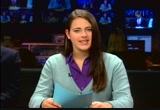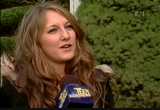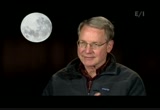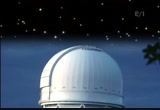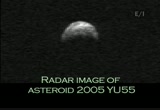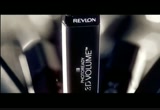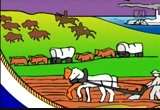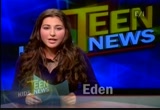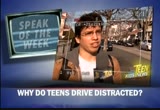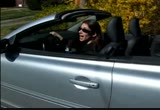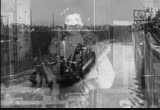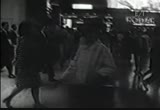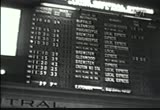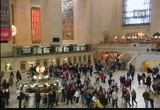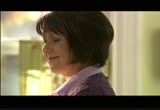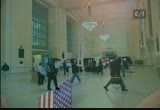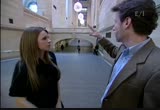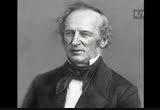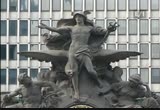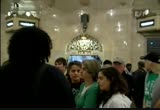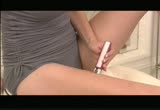tv Teen Kids News KRON July 21, 2012 2:30pm-3:00pm PDT
2:30 pm
>> here's what's happening on "teen kids news." >> asteroids. we're bombarded by them all the time. i'll report on nasa's efforts to make sure we don't get hit by a big one. >> greek gods, hidden tunnels, and world war ii spies. they're all part of the nation's largest train terminal. join us as we take a tour. >> i'll tell you why kansas owe. >> behind the wheel, your everyday distractions can turn into dangerous habits. >> and we're just getting started, so stay tuned.
2:31 pm
>> welcome to "teen kids news." i'm mwanzaa. >> and i'm livia. here's our top story for this week. >> scientists call them "neos" -- near-earth objects. they're asteroids and comets that might someday be on a course to collide with our planet. it might sound like a movie plot, but tyler tells us that nasa takes neos very seriously. in fact, all should. >> so, do you worry that something from outer space may crash into the earth? >> i think the chances are pretty slim. >> sometimes, like when i'm daydreaming in the middle of history class. >> no. i don't worry about something from outer space crashing into the earth. >> i don't worry about it a lot because i feel like we would have had a lot of warning from a lot of people and on the news, so i don't think that it's much
2:32 pm
to worry about. >> the universe isn't quite as empty as it seems. icy comets and rocky asteroids have been hurtling through space since time began. they're formed and propelled by explosions, collisions, and gravity. and they can be gigantic. this asteroid is 36 miles across. that's almost as wide as the state of rhode island. fortunately, most of these celestial wanderers are a lot smaller. >> pebble-sized objects hit the atmosphere on a daily basis. that's what you see when you see a shooting star. basketball-sized objects hit the earth's atmosphere a couple times a day, and if you're lucky enough to see one, it'll be a fireball event, but they don't cause any damage. >> home base for the neo program is the jet propulsion laboratory at the california institute of technology. their mission -- to watch the skies. >> back in 1998, nasa started a program to actually discover near-earth objects and track them for 100 years into the
2:33 pm
future. >> they also study neos of the distant past, like the one they think wiped out the dinosaurs. >> it is thought by most scientists that a near-earth object about 6 miles in diameter actually struck the earth, threw up dust and debris into the earth's atmosphere, shut down much of the sunlight, which, of course, killed the plants and the animals that lived on the plants, so the dinosaurs checked out about 65 million years ago as a result of a near-earth-object impact. >> another neo carved this crater in arizona about 50,000 years ago, and the big ones are still coming down. in 2008, there was a strange explosion above the african desert. scientists say it was caused by a neo that almost hit the planet. >> and pieces were found on the desert floor, and so scientists are now studying those pieces -- or meteorites -- to understand what this asteroid was made of. >> the whole world needs to know when another big neo might hit,
2:34 pm
so nasa is part of an international effort to watch and plan. >> so the goal is to find them and track them and predict that they might make an earth impact, say, 10, 20, 30 years into the future, and if we have that much time, we have the technology to deal with it. for example, you could run a spacecraft into them, slow them down just enough so that in 10 or 20 years, when they're predicted to hit the earth, they wouldn't. >> it's not science fiction. in the 1990s, nasa sent an unmanned spacecraft to study a giant asteroid named "eros." not only did the craft orbit the asteroid several times, it actually landed on it. [ crash ] you can check out the latest on neos by going to nasa's website. there's a link to it at teenkidsnews.com. >> we're currently tracking well over 7,000 near-earth objects, near-earth asteroids, and comets. none of them represent a serious threat for the next hundred years. >> but we do get close calls, like this one, named "yu55."
2:35 pm
nasa saw it coming back in 2005 and projected a path that would bring it within about 200,000 miles -- just a stone's throw away in galactic distance. its recent flyby gave us an opportunity to study it closely, and that's good, because neos could serve a purpose in the future. >> so, near-earth objects are not just threats, they may be the watering holes and fueling stations for future interplanetary travel. >> so, next time you see a falling star, make a wish. wish that we don't hatoo close an encounter with a neo. for "teen kids news," i'm tyler. >> there's a lot more ahead, so stick with us. >> "teen kids news" will be right back. the talking. [announcer:] new revlon® photoready 3d volume™ mascara the round tip brush coats even the tiniest lash. the innovative formula reflects every lash... for a 100% more magnified look.
2:37 pm
>> ever take a close look at your state flag? you should, because you might be surprised at how much you can learn from it. here's scott with this week's lesson. >> in 1803, president jefferson made one of the greatest land deals in history. the louisiana purchase doubled the size of the united states. eventually, the area would make up all or part of 15 new states, including kansas. >> kansas is a flag meant to represent "manifest destiny." there are three separate images of people on the flag, all moving westward. >> manifest destiny was the belief that the american expansion across the continent was both inevitable and justifiable. >> in the foreground, you see a farmer plowing his land. just beyond the farmer, you see a wagon train, also heading west.
2:38 pm
in the background, you see native americans hunting bison. there's also a steamboat on the kansas river, meant to represent commerce. life for the pioneers was not easy, and the state motto is "ad astra per aspera," which means "to the stars through difficulties," which is certainly a reference to how hard it was to settle the land. >> within the state seal, 34 stars represent kansas' place as our 34th state. >> above that state seal, there is a blue-and-gold band meant to reference the french and the louisiana purchase. >> and at the very top is the state flower -- the sunflower. believe it or not, in kansas, it used to be illegal to serve ice cream on cherry pie. i have no idea why. if you know, send us an e-mail at teenkidsnews.com. with flag facts, i'm scott. >> "gps" stands for "global positioning system." it links to an orbiting satellite to determine your location. cars and cellphones use gps to
2:39 pm
get directions. now gps is being put in children's shoes -- to help parents keep track of their kids. so your little brother or sister may soon have a satellite for a babysitter. >> this report is brought to you by the national road safety foundation. >> even though there's been a lot of talk about not driving distracted, many teens still do. why do you think that is? >> because, like, some might have short attention span. like, they might want to text their friends, like, and see what's going on, and then they want to listen to the music. >> well, mostly because sometimes, we are so attached to our cellphones now -- now that it has facebook, tumblr, twitter, everything -- that we can't put it down. and even driving, we just want to check it. >> well, i mean, in this world, i think we're really distracted by everything -- our phones, our ipods and stuff -- so, i mean,
2:40 pm
maybe it's just the generation i guess. >> i think they have too much on their mind related to family and school. >> they could be in a car with their friends and gossiping. 'cause, like, they haven't been driving for very long, so they're not used to having to pay attention for -- so, i guess there's just a lot of distractions from their friends. >> they probably think that, when they hear about it on the news and things, that that kind of thing couldn't happen to them. but i think teens should be more realistic that it does happen to kids like them. >> i think they don't really have as much concern for their safety as they do for, you know, talking to their fiends or being cool. >> i have a feeling it could be because they are very, like, in a rush, or, like, they're stressed of things. like, maybe if they're late for something, they could be driving not so carefully. >> i think they don't take it seriously because maybe they think it won't happen to them. >> it could certainly happen to anyone. so, before you turn on the car, turn off the distractions.
2:43 pm
>> it's rich in history and host to more than half-a-million visitors each day. kristen gives us an insider's tour of one of new york's most magnificent landmarks. [ loudspeaker chatter ] >> welcome to grand central terminal, the busiest train station in the country. >> grand central was built because there was a new technology in the mid-1800s, which was trains. [ train whistle blows ] and it was rapidly replacing the earlier modes of transportation. in order to understand theation. importance of grand central, you have to understand the importance of the railroads to the united states and to the world at that time. before the railroads came along, the only way to get across the country or from any point was either by horse-and-carriage or by canal, which was very slow. the railroads revolutionized the ability to move quickly across
2:44 pm
the country, and they became an extraordinarily powerful business. >> so powerful, in fact, that in 1947, over 65 million people -- the equivalent of almost half our nation's population at the time -- passed through grand central in just one year. that gave birth to a popular saying in the 1940s -- "busier than grand central station." except, that name is not quite correct. >> the real name of this building is grand central terminal, and the reason for that is that the trains terminate here. >> of course, trains also originate from here. grand central is a sprawling complex of ramps, stores, tracks, and huge spaces. >> what you see, actually, here, we like to say is "the tip of the iceberg." there is so much more that goes on behind the scenes. this is just the public portion where the actual people come through after having gotten off of their trains or coming in from the street. >> one of the things the public never saw was the secret train platform hidden below. it was specifically designed for
2:45 pm
one very special passenger. >> we shall send you... >> there was a private platform that was built underneath the waldorf-astoria hotel, which is one of the nicest hotels in new york and is built directly above the train tracks. and the platform was used for presidents. franklin roosevelt himself, who was not able to walk, got off of his private train car in his wheelchair and go directly to a private elevator that would take him up and into his suite at the waldorf-astoria. >> roosevelt was president during world war ii. at the time, there was concern that grand central could be the target of sabotage. >> there's one area of the terminal which is very, very deep below the ground, where power was converted, electrical power was converted, for use by the trains, and it was such a sensitive area that it's very heavily protected. there was fear, at one point, that spies would be able to get in there, and one handful of sand thrown into any of that machinery would shut the entire railroad system down and cripple the city. so it was very, very carefully
2:46 pm
protected, and even to this day, the public is not allowed to go down there. >> don't worry, there's plenty to see in the public areas. to give us a greater appreciation for this historic building, frank took me on a walking tour. >> well, this is one of the great ramps that was the invention of the architects who designed the building. there were two groups of architects. one was responsible for the architecture and the other for the movement through the building itself. and the ramps were to enable people to move very quickly from upper levels to lower levels if they were carrying their baggage with them. >> originally, a skyscraper was supposed to be built above grand central, but it was too expensive, so plans were scrapped. >> so instead, at the very last minute, relatively, the architect decided to put in this barrel-vaulted ceiling with a painting of the constellation. this mural was repainted on a new surface in 1940 because the original had become so dirty from automobile pollution, from
2:47 pm
smoke, from the trains, from cigarette smoke. it's kind of hard to see -- you really have to be looking for it, but that hole was cut in 1958 so that a wire could be suspended through the ceiling. it was connected to the steel structure that holds the roof of the terminal of the main concourse up. and an atlas rocket was suspended right in the middle of the space here, and the reason for that was that russia had just launched sputnik, its first satellite, and the space race was off in the united states, and americans were very nervous about russia being ahead of us technologically, by launching this rocket. so the united states chose grand central, which really is a town hall where important news is delivered to the most people, as a place to reinforce the strength of america so that people could be patriotic and feel confident that we were in the race and we could also launch our own rockets, just like the russians. >> you'd think a building that represented so much that was great about america would be
2:48 pm
considered a historical treasure, yet it came surprisingly close to being torn down. that and more, when we return. hey, did you hear about the new prevention benefits from medicare? the health care law gives us a yearly wellness visit to talk with our doctor about our care. medicare also covers recommended cancer and prevention screenings. plus, fifty percent off brand name prescription drugs... if you're in the donut hole. so i can get the prescriptions i need... to stay healthy. word sure gets around. [ male announcer ] tell your friends and family. learn more at medicare.gov or call 1-800-medicare. share the news. share the health! hi, sweetie. [ beep ] man: how's it going, buddy? i'm bored.
2:49 pm
[ beep ] i think i'll ride my bike. [ tv playing ] [ beep ] it may never be this easy to help your kids find balance, but you have more power than you know. the we can! parents' handbook and web site can help you maximize that power. you'll learn how to help kids choose healthier foods... and how to make it fun for them to get active. who can help kids maintain a healthy weight? we can! visit the we can! web site for a free parents' handbook, plus tips, tools, and resources. a message from the u.s. department of health and human services.
2:50 pm
2:51 pm
success of the railroads and the railroad companies that owned them. >> but by the 1950s, the nation's new highways made traveling by car more popular, and flying was really taking off. it looked like the end of the line for passenger railroads. in the 1960s, proposals were made to tear down grand central, but jacqueline kennedy onassis, president john f. kennedy's widow, came to the rescue. she helped save the beautiful building. today, the emphasis is on preservation and restoration. >> what you see, kristen, is what the terminal looked like in 1913, when it was finished. but in 1927, because they needed additional room for the ticket sellers, they built a ceiling over this space, right at this heavy cornice line here, so that when you came down the ramps, you felt like you were going down into a basement of grand central. as architects, we thought that there was an opportunity to remove all of that, put that somewhere else, and once again restore this magnificent view of
2:52 pm
the skylights, of the chandeliers, and, more importantly, of the sky ceiling and the main concourse beyond with all the natural light coming back in, and we think it's probably the most important and successful change that we made, as restoration architects, to make the terminal great again. this is known as the "whispering gallery," where we have our -- they're called "guastavino tiles." and it's a vaulted structure, which is self-supporting and very strong. it has this wonderful quality that, if you go off into the corner, you have two people on either side, and you whisper into the corners, you can hear very clearly what someone is saying on the other side. so we should try it. why don't you go in that corner, and i'll go over here. >> this is really amazing architecture. >> it is. it's very exciting architecture. this is one of many examples of the acorn and oak-leaf clusters that are displayed throughout the terminal. the acorn and oak leaf was the motif for the family crest of the vanderbilts. >> cornelius vanderbilt created a railroad empire in the 1800s.
2:53 pm
it helped make the vanderbilts one of the richest families in america. >> so, they used their crest and put it in different materials throughout the entire terminal, and it's very fun to go through the building and find different examples of them. >> it's not just grand central's interior that's impressive. >> this was intended to be seen as a triumphal entry into new york city. it's modeled on the great roman arches, which were intended to be monuments to the great war battles of the romans. so it has that same kind of idea of entry into and outside of new york city. and it has many symbols on top of it and throughout the facade -- symbols of new york city. you see thalf moon, which was henry hudson's ship. on the other side is a windmill, which refers to the original dutch settlers of new york. and then on the top is the great monumental sculptural element, which has three gods. >> the gods -- hercules, mercury, and minerva -- came from greek and roman mythology. they represent strength, commerce, and wisdom.
2:54 pm
even the clock is special. tiffany glass lines the numbers and the hands. >> it's very difficult to see, but when the light shines on it, it's quite beautiful and picks up in different colors. this is a really wonderful -- probably one of the most spectacular places to be in grand central and in the entire city. not very many people actually get to come up here. but what you can see from here that you can't see from down below -- first of all, you get a sense of the scale of the building, how large it really is. you get to experience the many different kinds of motion that occur here. kristen, behind you is the information booth, which is really at the center of the main concourse. it's probably -- we like to think of it as one of the most famous places in new york city. if you tell someone to meet you at the clock in grand central, they know exactly where to go. it's at the center of 43rd street to east-west and park avenue to north-south, and it really is right in the center of the main concourse, and we like to think it's the center of new york city. even if another train were not to come through here, it would still be an important place in new york city for people to come
2:55 pm
2:57 pm
>> want to make the grade? natalie has some great advice. >> there's something really amazing about history. it happens every day. so, while it's great that you're watching this program, you might want to make the news a part of your daily diet. if you read just the front page of the newspaper every day between now and your high-school graduation, you'll be a lot more aware of your world than many of your classmates. knowing what's going on will not
2:58 pm
only make you a better student, but a better citizen. i'm natalie, here to help you make the grade. >> this report is brought to you by birds eye and nickelodeon. >> jennette mccurdy plays sam on the popular show "icarly." she's drumming up excitement about veggies. >> veggies rock! >> unfortunately, a lot of us don't realize that. in fact, nine out of 10 kids aren't eating as many vegetables as they should. the goal of the "icarly" icook with birds eye program is to change that. >> with all the variety, colors, and surprisingly delicious taste packed into birds eye vegetables, anyone can get crazy in the kitchen, including you! >> the program is looking for creative ways you and your parents can cook up veggies. your clever creation may be featured on an upcoming episode of "icarly." and you can enter for a chance to win a trip to the set of a nickelodeon show and meet
2:59 pm
jennette mccurdy. >> so join me in celebrating veggies! >> all it takes is a recipe, a photo, and a "veggie" good idea. to find out more, you can go to nick.com/birdseye. for "teen kids news," i'm diyu. >> that's it for this week. thanks for joining us. >> we'll see you next week on "teen kids news."
343 Views
Uploaded by TV Archive on

 Live Music Archive
Live Music Archive Librivox Free Audio
Librivox Free Audio Metropolitan Museum
Metropolitan Museum Cleveland Museum of Art
Cleveland Museum of Art Internet Arcade
Internet Arcade Console Living Room
Console Living Room Books to Borrow
Books to Borrow Open Library
Open Library TV News
TV News Understanding 9/11
Understanding 9/11
